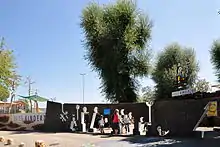Rapperswil
Rapperswil (Swiss German: [ˈrɑpːərʃˌʋiːl] or [ˈrɑpːərsˌʋiːl];[2] short: Rappi) is a former municipality and since January 2007 part of the municipality of Rapperswil-Jona in the Wahlkreis (constituency) of See-Gaster in the canton of St. Gallen in Switzerland, located at the east side of the Lake Zurich.
Rapperswil | |
|---|---|
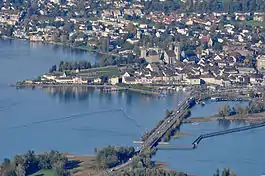 Rapperswil as seen from Etzel mountain: Capuchin monastery to the left, Rapperswil castle and St. John's church in the background, Lake Zürich harbour and Altstadt in the foreground respectively Seedamm, wooden bridge and upper Lake Zürich to the right (October 2010) | |
 Coat of arms | |
Location of Rapperswil 
| |
 Rapperswil 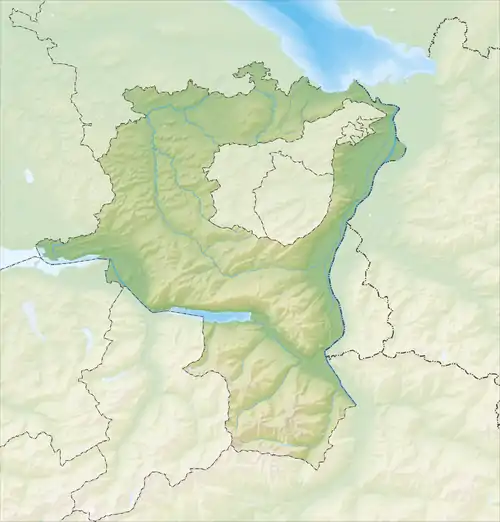 Rapperswil | |
| Coordinates: 47°13.6′N 8°49′E | |
| Country | Switzerland |
| Canton | St. Gallen |
| District | See-Gaster |
| Municipality | Rapperswil-Jona |
| Government | |
| • Mayor | Stadtpräsident/Stadtammann (list) |
| Area | |
| • Total | 1.74 km2 (0.67 sq mi) |
| Elevation | 409 m (1,342 ft) |
| Population (2018-12-31)[1] | |
| • Total | 2,618 |
| • Density | 1,500/km2 (3,900/sq mi) |
| Time zone | UTC+01:00 (Central European Time) |
| • Summer (DST) | UTC+02:00 (Central European Summer Time) |
| Postal code(s) | 8640 |
| SFOS number | 3336 |
| Surrounded by | Altendorf (SZ), Freienbach (SZ), Jona, Bollingen, Lachen (SZ) |
| Website | www SFSO statistics |
Tourist attractions
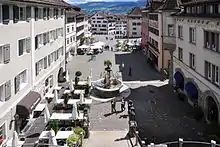
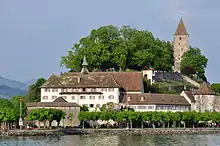
The town's main sights are concentrated in the Altstadt of Rapperswil and can be seen while strolling through the medieval alleys. The main sights of Rapperswil are its rose gardens, Rapperswil Castle, the reconstructed wooden bridge to Hurden with its bridge chapel Heilig Hüsli located at Seedamm, the Kapuzinerkloster (Capuchin's monastery), the remains of the Middle Ages fortifications located on Lake Zürich, Lindenhof hill, Herrenberg, Engelplatz, Hauptplatz, Bühlerallee and Fischmarktplatz at Rapperswil harbour.
Rapperswil is often referred to as the "town of roses" (Rosenstadt) because of its extensive displays of roses in three designated parks. No less than 15,000 plants of 600 different kinds may be viewed between June and October. There is also a rose garden in the town center, accessible to blind and disabled people.[3]
The old town (Altstadt) is dominated by the Schloss Rapperswil located at the peninsula called Endingen, Lindenhof and Herrenberg on Lake Zürich perched atop this rocky hill at the bay of Kempraten. The castle dates back to the early 13th century (first mentioned in 1229). In 1350, it was destroyed by Rudolf Brun, the mayor of Zürich, and was rebuilt in 1352/54 by Albrecht II, Duke of Austria. Deer inhabit lands surrounding the castle.[4] Since 1870, the castle has been home to the Polish National Museum created by Polish émigrés, including the castle's lessee and restorer, Count Wladyslaw Broel-Plater.[5]
A small Capuchin's monastery was established in 1606 at the lakeside Endingerhorn as a Catholic counterpart to the Reformation's centre in the city of Zürich. The monastery buildings belong to the citizens of Rapperswil (Endingen itself belongs to the Einsiedeln Abbey) rather than to the monks who inhabit it, and is still in use.[6] The main churches in town include the Roman Catholic St. John's Church (built in early 13th century),[7] the cemetery chapel (Liebfrauenkapelle) and a small Protestant church.
The locational advantage of the place attracted the national Circus Knie who built its headquarters in Rapperswil in 1919.[8] The circus is now also responsible for the Circus Museum [9] and the Knie's Kinderzoo located in Rapperswil which is particularly aimed at children.[10] Rapperswil also hosts the Hochschule für Technik Rapperswil HSR (University of Applied Sciences Rapperswil) [11] and an Economics school for parts of the cantons Zürich and St. Gallen.
Zürichsee-Schifffahrtsgesellschaft (commonly abbreviated to ZSG) operates passenger vessels on the Lake Zürich (Zürichsee),[12] connecting the surrounding towns between Zürich-Bürkliplatz and the Rapperswil peninsula with its harbour area.
History
Early history
Lordship (County) of Rapperswil Herrschaft (Grafschaft) Rapperswil | |||||||||
|---|---|---|---|---|---|---|---|---|---|
| 1220–1464 | |||||||||
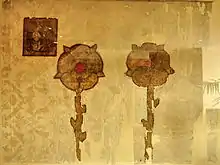 Juliusbanner (1512)
 Coat of arms
| |||||||||
| Status | State of the Holy Roman Empire | ||||||||
| Capital | Rapperswil | ||||||||
| Government | Principality | ||||||||
| Historical era | Middle Ages, Early Modern period | ||||||||
• Rapperswil founded | 1229 (official date) | ||||||||
• Lordship established | ca 1233 1220 | ||||||||
1309–58 | |||||||||
1415–58 | |||||||||
1440–46 | |||||||||
1458–1798 | |||||||||
1798 1464 | |||||||||
| 19 February 1803 | |||||||||
| |||||||||
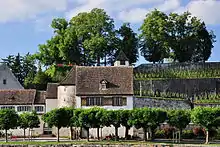
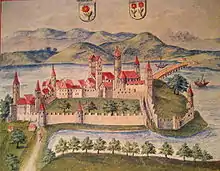
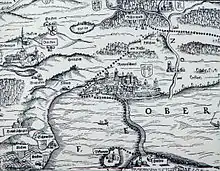

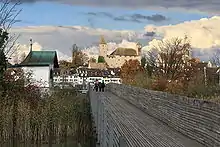
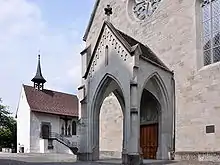
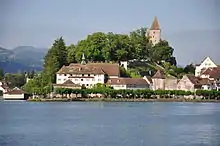

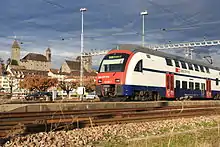
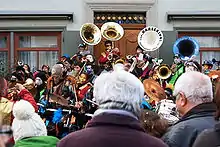
Settlements in the region of Rapperswil date back to at least 5000 years ago. Archaeological relicts have been found at the Technikum island settlement,[13] and the remains of a first wooden bridge (1523 BC, reconstructed in 2001) to Hurden located on the Obersee lakeshore nearby the Technical University (HSR) respectively the so-called Heilig Hüsli at the northwestern part of the Seedamm area. The three neighbouring Prehistoric settlements, as well as the early lake crossings, are part of the UNESCO World Heritage Site Prehistoric Pile dwellings around the Alps.[14][15] In Kempraten, two kilometers away, there was a probably Helvetic settlement;[16][17] and in the beginning of the 1st century AD, the Roman vicus Centum Prata (meaning 100 meadows) became an important trade center on the way to the Roman heartland. The neolithic bridge between Hurden and Rapperswil was renewed by the Romans at least around 165 AD.
Historians mention a 10th-century ferry station assumably at the so-called Einsiedlerhaus in Rapperswil – in 981 AD as well as the vineyard on the Lindenhof hill – between Kempraten on Kempratnerbucht, Lützelau and Ufenau island and assumably present Hurden, which allowed the pilgrims towards Einsiedeln to cross the lake before the prehistoric bridge at the Seedamm isthmus was re-built in 1358.[18]
Counts of Rapperswil
Rapperswil Castle and the fortifications of the former locus Endingen (given by the Einsiedeln Abbey) were built by the Counts of Rapperswil, i.e. by Rudolf II and his son Rudolf III von Rapperswil around 1200: The town was founded when the nobility of Rapperswil moved from Altendorf across the lake to Rapperswil. On the peninsula at Oberbollingen, the St. Nicholas Chapel is mentioned, where around 1229 a small Cistercian (later Premonstratensian) monastery was established by the house of Rapperswil; in 1267 it was united with the nearby Mariazell-Wurmsbach Abbey. St. Martin Busskirch is one of the oldest churches around upper Lake Zürich. Even the citizens of Rapperswil had to attend services in Busskirch until Count Rudolf II built the Stadtpfarrkirche on Herrenberg next to Rapperswil Castle on Lindenhof hill. Known members of the family are Countess Elisabeth von Rapperswil (around 1252/62 –1309), her sons Wernher von Homberg, Reichsvogt and minnesang poet, and Count Johann I. von Habsburg-Laufenburg-Rapperswil (* around 1295/97, † 1337). His son Johann II († 1380), the opposition's leader against Rudolf Brun, the mayor of Zürich, was arrested for two years, and the town walls of Rapperswil, its castle and Altendorf castle were destroyed by Brun in 1350.
Modern history
Between 1358 and 1360 Rudolf IV, Duke of Austria, built a wooden bridge across the lake that has been used to 1878 – measuring approximately 1,450 metres (4,757 ft) in length and 4 metres (13 ft) wide; 546 oak piles have been installed. In 1415, the town bought freedom for itself. In 1442, during Old Zurich War, Rapperswil was in alliance with Zürich and the Habsburg Dynasty. In 1458 Rapperswil was controlled by the Swiss Confederation as a so-called Gemeine Herrschaft, i.e. under control of two cantons (Glarus and Schwyz) of the Old Swiss Confederation and their representative, a Vogt at Rapperswil castle.
Because of its strategic location along important infrastructure lines, and because of flourishing trade, the town grew rich. This allowed a certain degree of freedom (especially within the Habsburg-controlled territories and) within the Swiss Confederation which ended with the formation of the Swiss cantons by Napoleon in 1799. In 1656 and 1712 (the First War of Villmergen and the Toggenburg War, or Second War of Villmergen, respectively), Rapperswil was involved in wars between the Catholic and Reformed cantons of the Old Swiss Confederation. Rapperswil was at first part of the Helvetic and the canton of Linth's capital city. After the 1803 Act of Mediation, it joined the canton of St. Gallen, and the former Herrschaft Rapperswil was split into the municipalities of Rapperswil and Jona.
On 1 January 2007 the former municipalities of Rapperswil and Jona merged to form a new political entity: Rapperswil-Jona has a population of 25,777 (December 2007). This makes it the second-largest town in the canton after the capital of St. Gallen itself.
Culture
Ironman 70.3 Switzerland and the Triathon Challenge took place in Rapperswil-Jona on 6 June 2010, and was repeated several times. The blues'n'jazz festival, taking place since 1998, is held at the end of June. Every three years Seenachtsfest is celebrated one weekend in August, attracting nearly 100,000 visitors to a spectacular fireworks, for the next time in summer 2018.[19] Rapperswil is the home of the Rapperswil-Jona Lakers, and their Diners Club Arena is situated on Obersee lakeshore. Kunst(Zeug)Haus is a vibrant center of Swiss contemporary art, housed in a former Swiss Military armory (Zeughaus).[20] Herzbaracke is a swimming theatre, cabaret and restaurant on Lake Zürich at different locations, among them Zürich-Bellevue and Rapperswil harbour. Eis-zwei-Geissebei is a Carnival festival in Rapperswil on Shrove Tuesday, and Christkindlymärt is a Christmas funfair celebrated in late December, and last but not least, Radio Zürisee is situated in Rapperswil opposite of the Rapperswil railway station, and Obersee Nachrichten at Hauptplatz plaza.
In Rapperswil there are several sites situated that are listed as Swiss heritage sites of national significance: Schloss Rapperswil with the Polish Museum including the Polish national archive, the medieval Rathaus (town hall) located at the Hauptplatz square, and the Seedamm region including Heilig Hüsli and the remains of the prehistoric wooden bridges respectively the neolithic stilt house settlements located there.[21] The latter are part of the UNESCO World Heritage Site "Prehistoric Pile dwellings around the Alps".[22][23]
Cultural heritage
Located on Obersee lake shore at the Seedamm isthmus between the Zürichsee and the Obersee lake area, the area was in close vicinity to the prehistoric lake crossings, and neighboured by four Prehistoric pile dwelling settlements: Freienbach–Hurden Rosshorn,[24] Freienbach–Hurden Seefeld,[25] Seegubel[26] and Rapperswil-Jona–Technikum.[13] Because the lake has grown in size over time, the original piles are now around 4 metres (13 ft) to 7 metres (23 ft) under the water level of 406 metres (1,332 ft).
As well as being part of the 56 Swiss sites of the UNESCO World Heritage Site Prehistoric pile dwellings around the Alps, the settlements are also listed in the Swiss inventory of cultural property of national and regional significance as Class A objects of national importance.[27]
Transportation
Rapperswil railway station is a nodal point of the Südostbahn (SOB) and the S-Bahn Zürich on the lines S5, S7, S15, S26 and S40. Its train station is a 36-minute (S5) ride from Zürich Hauptbahnhof and a 55-minute ride to St. Gallen with InterRegio respectively Voralpen Express (Südostbahn). The rail tracks and the infrastructure, excluded the train station's building, have been renewed by June/July 2016.[28] Since 2008 the bus service in Rapperswil-Jona has been provided by the Verkehrsbetriebe Zürichsee und Oberland (VZO).
As of 2016, an average of 26,000 road vehicles cross the Seedamm causeway and the Bahnhofstrasse road in Rapperswil every day. As of 30 June 2016, Rapperswil-Jona is expected to participate as the first Swiss city in a pilot project for so-called Mobility pricing in order to relieve the traffic on road and rail during rush hours.[29]
Gallery

 Fischmarktplatz
Fischmarktplatz Engelplatz
Engelplatz Herrenberg
Herrenberg Stadtmuseum Rapperswil, Liebfrauenkapelle, Stadtpfarrkirche St. Johann (St. John's church) and the Schloss, as seen from Kempraten-Lenggis
Stadtmuseum Rapperswil, Liebfrauenkapelle, Stadtpfarrkirche St. Johann (St. John's church) and the Schloss, as seen from Kempraten-Lenggis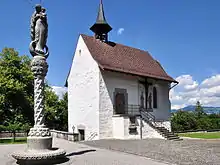 Liebfrauenkapelle between Schloss and Stadtpfarrkirche
Liebfrauenkapelle between Schloss and Stadtpfarrkirche St. Ursula chappel (re-built in 1607)
St. Ursula chappel (re-built in 1607) Reformierte Kirche (built in 1841)
Reformierte Kirche (built in 1841)_IMG_8578_ShiftN.jpg.webp) Eis-zwei-Geissebei on the main square at Rathaus Rapperswil
Eis-zwei-Geissebei on the main square at Rathaus Rapperswil Herzbaracke at Rapperswil harbour
Herzbaracke at Rapperswil harbour See-Quai in Rapperswil, Bühlerallee to the left, Lindenhof hill in the background
See-Quai in Rapperswil, Bühlerallee to the left, Lindenhof hill in the background Lindenhof and Deer park towards to the Schloss
Lindenhof and Deer park towards to the Schloss
Notable people
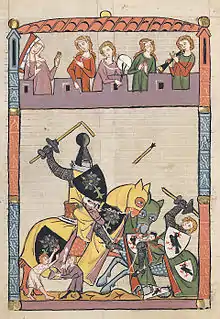
- early times
- (Saint) Kunigunde of Rapperswil died in early 4th century AD, a Christian saint, beatified 1504
- Elisabeth von Rapperswil (c.1251 – 1309) the last countess of the House of Rapperswil
- Albrecht von Rapperswil (13th century) one of the Minnesingers featured in the Codex Manesse
- Wernher von Homberg (1284–1320) a knight in the service of Henry VII, Holy Roman Emperor
- Count Johann I (Habsburg-Laufenburg) (c.1297–1337), son of Countess Elisabeth von Rapperswil
- Count Johann II (Habsburg-Laufenburg) (c.1330 – 1380), son of Johann I
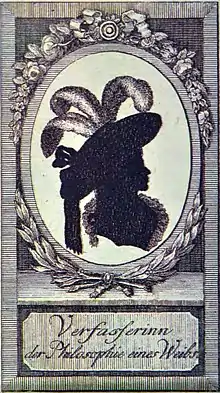
- modern times
- Valentin Molitor (1637–1713) a composer and Benedictine monk
- Marianne Ehrmann (1755–1795) early woman novelist, publicist and journalist [30]
- Felix Maria Diogg (1762–1834) a painter and Swiss Classicism portraitist
- Count Wladyslaw Plater (1808–1889) a Polish count, in 1870 co-founded the Polish Museum, Rapperswil
- Joachim Raff (1822–1882) a German-Swiss composer, teacher and pianist
- Agaton Giller (1831–1887) a Polish historian, journalist and politician; co-founded the Polish Museum, Rapperswil
- Alwina Gossauer (1841–1926) one of the first Swiss women professional photographers [30]
- Franz Curti (1854–1898), opera composer
- Stefan Zeromski (1864–1925) a Polish novelist and dramatist; nominated four times for the Nobel Prize in Literature
- Martha Burkhardt (1874–1956) a painter and photographer [30]
- Josef Müller-Brockmann (1914–1996) a graphic designer and teacher
- Kurt Aepli (1914-2002) a silversmith, designer of fine jewelry and implements and teacher
- Josef Helbling (born 1935) a former cyclist, competed in the 1960 Summer Olympics
- Gerold Späth (born 1939) an author, poet and writer [31]
- Hans Heinemann (born 1940) a former cyclist, competed in the 1960 and the 1964 Summer Olympics
- Alfredo Battistini (1953–2008) an Italian-Swiss sculptor, illustrator and athlete
- Alexander Hahn (born 1954) is an electronic media artist
See also
- Towns respectively villages of the municipality of Rapperswil-Jona: Bollingen, Busskirch, Jona, Kempraten, Rapperswil
- Points of interest: Circus Knie, Heilig Hüsli, Hochschule für Technik Rapperswil HSR (University of Applied Sciences Rapperswil), Holzbrücke Rapperswil-Hurden, Kapuzinerkloster Rapperswil, Knies Kinderzoo, Lindenhof, Paddle steamer Stadt Rapperswil, Polish Museum Rapperswil, Rapperswil Castle, Hintergasse, Rathaus Rapperswil, Seedamm, Stadtmuseum Rapperswil, Stadtpfarrkirche Rapperswil, Liebfrauenkapelle (Rapperswil), Wurmsbach Abbey, Rapperswil rose gardens
References
- https://www.pxweb.bfs.admin.ch/pxweb/de/; retrieved: 15 June 2020; publisher: Federal Statistical Office.
- Andres Kristol, Rapperswil SG (See) in: Dictionnaire toponymique des communes suisses – Lexikon der schweizerischen Gemeindenamen – Dizionario toponomastico dei comuni svizzeri (DTS|LSG), Centre de dialectologie, Université de Neuchâtel, Verlag Huber, Frauenfeld/Stuttgart/Wien 2005, ISBN 3-7193-1308-5 and Éditions Payot, Lausanne 2005, ISBN 2-601-03336-3, p. 727.
- "Rose gardens Rapperswil-Jona" (in German). vvrj.ch. Retrieved 2016-03-28.
- Castle of Rapperswil (official site) (in German)
- National Museum of Poland in Rapperswil (official site)
- Rapperswil monastery (official site) (in German)
- Pfarrei St. Johann (official site) (in German)
- Circus Knie (official site) (in German)
- Circus Museum Rapperswil (official site) (in German)
- Knie's Kinderzoo (official site) (in German)
- University of Applied Sciences Rapperswil (HSR) (official site) (in German)
- Zürichsee Schifffahrtsgesellschaft Boat schedules, mainly (in German)
- "Sites Switzerland: Rapperswil-Jona–Technikum (CH-SG-02)". palafittes.org. Archived from the original on 2014-10-07. Retrieved 2014-12-07.
- "Prehistoric Pile Dwellings in Switzerland". Swiss Coordination Group UNESCO Palafittes (palafittes.org). Archived from the original on 2014-10-07. Retrieved 2014-12-07.
- "World Heritage". palafittes.org. Archived from the original on 2014-12-09. Retrieved 2014-12-07.
- Unterwasserarchäologische Projekte Kanton St. Gallen
- Neue Zürcher Zeitung (20/21 January 2001): Die Brücke auf dem Grund des Zürichsees
- "Das Einsiedlerhaus in Rapperswil wechselt den Besitzer". Obersee Nachrichten (in German). Kapuzinerkloster Rapperswil, published by Markus Turnherr, Stadtarchivar. Retrieved 2015-09-12.
- www.seenachtsfest-rj.ch (in German)
- Kunst(Zeug)Haus Rapperswil website (in German)
- Swiss inventory of cultural property of national and regional significance Archived 2009-05-01 at the Wayback Machine
- UNESCO World Heritage Centre
- palafittes.org Archived 2011-09-02 at the Wayback Machine (in German)
- "Sites Switzerland: Freienbach–Hurden Rosshorn (CH-SZ-01)". palafittes.org. Archived from the original on 2014-10-07. Retrieved 2014-12-08.
- "Sites Switzerland: Freienbach–Hurden Rosshorn (CH-SZ-02)". palafittes.org. Archived from the original on 2014-10-07. Retrieved 2014-12-08.
- "Sites Switzerland: Rapperswil-Jona/Hombrechtikon–Feldbach (CH-SG-01)". palafittes.org. Archived from the original on 2014-10-07. Retrieved 2014-12-08.
- "Schweizerisches Inventar der Kulturgüter von nationaler Bedeutung: Kanton St. Gallen, A-Objekte" (PDF) (in German). bevoelkerungsschutz.admin.ch. 2015-01-01. Archived from the original (PDF) on 2015-12-19. Retrieved 2015-09-14.
- Kristina Ivancic; Pascal Büsser (2016-06-26). "Bahnhof Rapperswil: Die Bauarbeiter leisten Knochenarbeit am Gleis" (in German). Limmattaler Zeitung. Retrieved 2016-06-30.
- "FOKUS: Mobility Pricing soll Pendlerverkehr entlasten" (in German). 10vor10. 2016-06-30. Retrieved 2016-06-30.
- Information boards on occasion of the 2015 exhibition Der Zeit voraus - Drei Frauen auf eigenen Wegen, Stadtmuseum Rapperswil-Jona.
- IMDb Database retrieved 20 December 2018
Literature
External links
| Wikimedia Commons has media related to Rapperswil. |
- Rapperswil-Jona (official site) (in German)
- Ortsgemeinde Rapperswil-Jona (in German)
- Tourist Information Rapperswil-Jona (in German)
- Rapperswil in German, French and Italian in the online Historical Dictionary of Switzerland.
